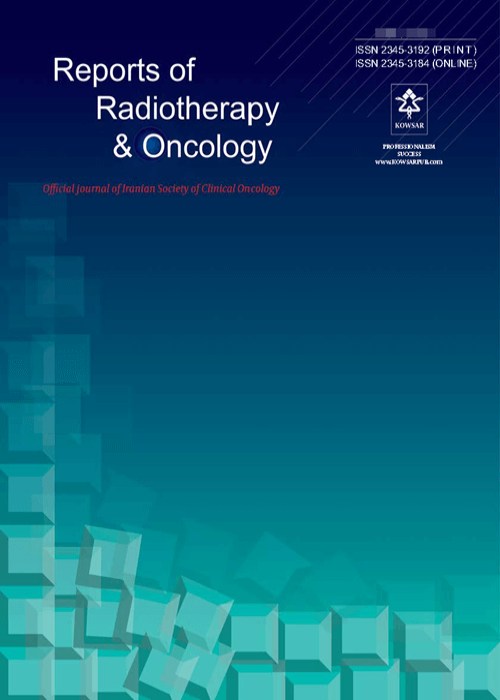فهرست مطالب
Reports of Radiotherapy and Oncology
Volume:2 Issue: 4, Dec 2015
- تاریخ انتشار: 1395/10/10
- تعداد عناوین: 5
-
-
Page 1Breast cancer is among the most common types of cancer and the second leading cause of cancer-related death in women. Therefore, finding treatments with the highest effectiveness and least side effects is of great importance. Curcuma langa, commonly known as curcumin, has many advantages, including antioxidant, antiinflammatory, anticancer, and wound-healing properties. The anticancer mechanisms include prevention of malignant cell formation, as well as reduction of angiogenesis and tumor growth, as documented in some malignancies, including pancreatic, ovarian, gastric, and colorectal cancers. Recent research has also documented curcumin activities against breast cancer, in particular molecular pathways involved in cell growth, differentiation, apoptosis, and suppression of inflammation. Therefore, the aim of the current review was to study the effects of curcumin on breast cancer.Keywords: Curcumin, Breast Cancer, Anticancer Effects
-
Page 2BackgroundIn intensity modulated radiotherapy (IMRT), leaf sequencing algorithm is used to control the multileaf collimator (MLC) to produce beam segments resulting in a beam intensity map for highly conformal dose coverage.ObjectivesA novel leaf sequencing algorithm based on the Langers integer programming method is proposed.MethodsOur algorithm selected the horizontal or orthogonal leaf direction of beam intensity maps as per Xia and Verheys algorithm with a new constraint to optimize the MLC leaf travel distance (LTD).ResultsComparison among the leaf sequencing algorithms from Xia and Verhey, Langer et al. and ours, both Langers and our algorithms have lower monitor units (8 and 10) compared to 15 of Xias algorithm. For the number of segment and LTD, our new algorithm has the smallest number and distance (5 and 7 cm) compared to both the Xias and Langers algorithm (7 and 24 cm and 6 and 20 cm). This revealed that model modifications could yield better results according to three criteria namely, total number of monitor unit, number of segment and LTD.ConclusionsIn conclusion of experimental comparison performed, our algorithm can generate photon beam in IMRT dose delivery with lower monitor unit, number of segment and LTD compared to the Xias and Langers algorithm.Keywords: Leaf Sequencing, MLC, IMRT, Dose Delivery
-
Page 3BackgroundPathological diagnosis of the brain tumors is very challenging. The current study aimed at evaluating the discordance between imaging data and pathologic diagnosis of patients with brain tumors.MethodsThe current descriptive study retrospectively assessed the medical documents of patients referred to neuro-oncology clinics of Omid and Emam Reza hospitals affiliated to Mashhad University of Medical Sciences, Mashhad, Iran from 2009 to 2010. The accordance of pathologic reports with imaging findings was studied and the smears were also reviewed in case of discordance.ResultImaging/pathologic discordances were found in 11 out of 240 (4.5%) patients, which in 82% of the patients was associated with diagnosis change.DiscussionThe current study showed that imaging/pathologic discordances existed and were accompanied by changes in management. Treatment approach and prognosis of patients with brain tumors substantially varies among the different subtypes and grades. Considering the limited sources in the developing countries such as Iran, reviewing the pathological findings of all patients is not practical. Therefore, it is suggested that 3 main diagnostic fields involved in the treatment of brain tumors (ie, neuro-oncology, neurosurgery, and pathology) should be familiar with all corresponding issues.Keywords: Pathology, Radiology, Brain Tumors Verification
-
Page 4BackgroundBrain metastasis is the most common intracranial tumor in adults. Addition of boost dose to brain metastases with stereotactic radiosurgery following whole brain radiation therapy with concurrent temozolomide showed improved outcomes; hence, the current study aimed at evaluating toxicity, efficacy, and quality of life (QOL) of addition of intensity-modulated radiation therapy (IMRT) boost to whole brain radiation therapy (WBRT) and concurrent temozolomide (TMZ) in patients with newly diagnosed brain metastases.MethodsTwenty patients with known primary histology, newly diagnosed brain metastases, underwent recursive partitioning analysis (RPA) class I/II, and fulfilling eligibility criteria were enrolled in the current study. Patients who initially received WBRT with concurrent TMZ were randomly assigned to receive IMRT boost to an additional 20 Gray (group A) or no further treatment (group B). Serial evaluations of toxicity (hematologic and non-hematologic), response (clinical, neurologic, and radiologic), and QOL were performed at 3 months and 6 months after the completion of Radiotherapy. The 2 groups were compared for toxicity, response, and QOL by appropriate statistical tests.ResultsAt the median follow-up of 5 months, patients in group A demonstrated similar toxicity, superior response, and better QOL in 3 domains (physical functioning, role functioning, and global health status).ConclusionsAddition of IMRT boost to WBRT and TMZ provided superior response and better QOL, without additional toxicity, compared with WBRT alone.Keywords: Brain Metastases, IMRT Boost, QOL, Temozolomide, WBRT
-
Page 5Radiotherapy is one of the most important branches of medical radiation physics, which deals with the treatment using ionizing radiation. Recurrence of the disease is a known problem with this treatment method. Recently, nanoparticles are introduced as sensitizer agents for the tumors. Their experimental evaluation confirmed their ability to improve the treatment. However, their quantitative assessment is required for clinical application. The current study employed the Monte Carlo method to quantitatively evaluate several influential factors. A slab head phantom with real material composition of brain tissues was simulated. Photon energy, type, and concentration of nanoparticles were investigated as influential factors. Gold, platinum, and silver were evaluated in the current study. There was an optimal energy for each nanoparticle near to the corresponding K-edge energy. The results also demonstrated that linear dose enhancement increased with an increase in the concentration of nanoparticles. Overall, the current study calculations highlighted silver nanoparticles as the most efficient nanoparticles in terms of impact on dose enhancement.Keywords: Photon-Therapy, Radio-Sensitized Tumor, Nanoparticles, Monte Carlo Simulation


